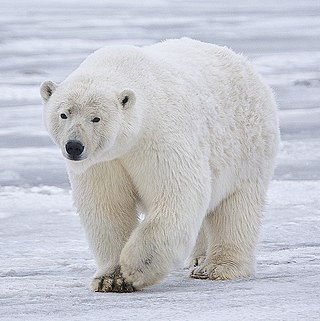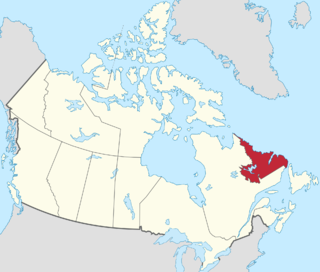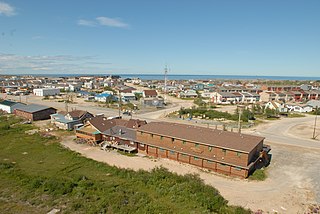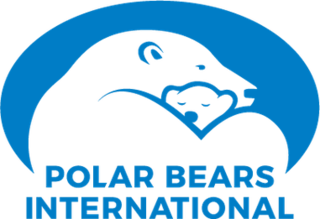
The polar bear is a large bear native to the Arctic and nearby areas. It is closely related to the brown bear, and the two species can interbreed. The polar bear is the largest extant species of bear and land carnivore, with adult males weighing 300–800 kg (660–1,760 lb). The species is sexually dimorphic, as adult females are much smaller. The polar bear is white- or yellowish-furred with black skin and a thick layer of fat. It is more slender than the brown bear, with a narrower skull, longer neck and lower shoulder hump. Its teeth are sharper and more adapted to cutting meat. The paws are large and allow the bear to walk on ice and paddle in the water.

The toonie, formally the Canadian two-dollar coin, was introduced on February 19, 1996, by Minister of Public Works Diane Marleau. As of 2023, it possesses the highest monetary value of any circulating Canadian coin. The toonie is a bi-metallic coin which on the reverse side bears an image of a polar bear by artist Brent Townsend. The obverse, since 2023, bear a portrait of King Charles III. It has the words CHARLES III / D.G. REX; before 2023, the words were in a typeface different to other Canadian coins.

The Arctic is a polar region located at the northernmost part of Earth. The Arctic region, from the IERS Reference Meridian travelling east, consists of parts of northern Norway, northernmost Sweden, northern Finland, Russia, the United States (Alaska), Canada, Danish Realm (Greenland), and northern Iceland, along with the Arctic Ocean and adjacent seas. Land within the Arctic region has seasonally varying snow and ice cover, with predominantly treeless permafrost under the tundra. Arctic seas contain seasonal sea ice in many places.

Hudson Bay, sometimes called Hudson's Bay, is a large body of saltwater in northeastern Canada with a surface area of 1,230,000 km2 (470,000 sq mi). It is located north of Ontario, west of Quebec, northeast of Manitoba, and southeast of Nunavut, but politically entirely part of Nunavut. It is an inland marginal sea of the Arctic Ocean. The Hudson Strait provides a connection between the Labrador Sea and the Atlantic Ocean in the northeast, while the Foxe Channel connects the Hudson Bay with the Arctic Ocean in the north. It drains a very large area, about 3,861,400 km2 (1,490,900 sq mi), that includes parts of southeastern Nunavut, Alberta, Saskatchewan, Ontario, Quebec, all of Manitoba, and parts of the U.S. states of North Dakota, South Dakota, Minnesota, and Montana. Hudson Bay's southern arm is called James Bay.

Labrador is a geographic and cultural region within the Canadian province of Newfoundland and Labrador. It is the primarily continental portion of the province and constitutes 71% of the province's area but is home to only 6% of its population. It is separated from the island of Newfoundland by the Strait of Belle Isle. It is the largest and northernmost geographical region in the four Atlantic provinces.

Grande Prairie is a city in northwest Alberta, Canada within the southern portion of an area known as Peace River Country. It is located at the intersection of Highway 43 and Highway 40, approximately 456 km (283 mi) northwest of Edmonton. The city is surrounded by the County of Grande Prairie No. 1.

Churchill is an Arctic port town in northern Manitoba, Canada, on the west shore of Hudson Bay, roughly 140 km (87 mi) from the Manitoba–Nunavut border. It is most famous for the many polar bears that move toward the shore from inland in the autumn, leading to the nickname "Polar Bear Capital of the World" and to the benefit of its burgeoning tourism industry.

Cochrane is a town in northeastern Ontario, Canada. It is located east of Kapuskasing, northeast of Timmins, south of Moosonee, and north of Iroquois Falls. It is about a one-hour drive from Timmins, the major city of the region. It is the seat of Cochrane District. The town's population is made up of about half anglophone and half francophone residents.

The Churchill Rocket Research Range is a Canadian former rocket launch site located 23 kilometres (14 mi) outside Churchill, Manitoba. The facility was used by Canada and the United States beginning in 1954 for sub-orbital launches of sounding rockets to study the upper atmosphere. The site was scientifically beneficial due to lying in the center of a zone containing high aurora activity. Over 3,500 sub-orbital flights were launched from the site.

Arviat is a predominantly Inuit hamlet located on the western shore of Hudson Bay in the Kivalliq Region of Nunavut, Canada. Arviat is derived from the Inuktitut word arviq meaning "Bowhead whale". Earlier in history, its name was Tikirajualaaq, and Ittaliurvik,.

The United States Penitentiary, Administrative Maximum Facility, commonly known as ADX Florence or the Florence Supermax, is an American federal prison in Fremont County to the south of Florence, Colorado, operated by the Federal Bureau of Prisons, a division of the United States Department of Justice. ADX Florence, constructed in 1994 and opened one year later, is classed as a supermax or "control unit" prison, that provides a higher, more controlled level of custody than a regular maximum security prison. ADX Florence forms part of the Federal Correctional Complex, Florence, which is situated on 49 acres of land and houses different facilities with varying degrees of security, including the adjacent United States Penitentiary, Florence High.

Wapusk National Park (; is Canada's 37th national park, established in 1996. The name comes from the Cree word for polar bear.

A grizzly–polar bear hybrid is a rare ursid hybrid that has occurred both in captivity and in the wild. In 2006, the occurrence of this hybrid in nature was confirmed by testing the DNA of a unique-looking bear who had been shot near Sachs Harbour, Northwest Territories, on Banks Island in the Canadian Arctic. The number of confirmed hybrids has since risen to eight, all of them descending from the same female polar bear.

Assiniboine Park Zoo is an 80-acre (32 ha) zoo at the west end of Assiniboine Park in Winnipeg, Manitoba, Canada. It has been best known for decades for its polar bear exhibit, of which the old enclosure was replaced in 2013 with Journey to Churchill.
The Seal River is a river in the Northern Region of Manitoba, Canada. It travels 260 kilometres (160 mi) from Shethanei Lake to the Hudson Bay. The river was nominated for the Canadian Heritage Rivers System in 1987 and was officially listed in 1992. In January 2024, the Governments of Canada and Manitoba and Members of the Sayisi Dene First Nation, O-Pipon-Na-Piwin Cree Nation, Northlands Denesuline First Nation and Barren Lands First Nation reached an agreement to designate the watershed as an Indigenous and community conserved area.

Polar Bears International (PBI) is a non-profit polar bear conservation organization. Their research, education, and action programs address the issues that are endangering polar bears. The organization also studies polar bears and monitors their activity data which helped lead to the animals being listed as a threatened species. While Churchill, Canada, serves as an important hub for PBI scientists and educators, the organization's work on behalf of polar bears spans the Arctic including Svalbard, Russia, and Alaska.

Polar Bear Shores is a polar bear exhibit at the Sea World theme park on the Gold Coast, Australia. As of 2023, the exhibit features three polar bears.
Timothy Francis Ball was a British-born Canadian public speaker and writer who was a professor in the Department of Geography at the University of Winnipeg from 1971 until his retirement in 1996. Subsequently Ball became active in promoting rejection of the scientific consensus on global warming, giving public talks and writing opinion pieces and letters to the editor for Canadian newspapers.

The Southern Hudson Bay taiga is a terrestrial ecoregion, as classified by the World Wildlife Fund, which extends along the southern coast of Hudson Bay and resides within the larger taiga biome. The region is nearly coterminous with the Hudson Plain, a Level I ecoregion of North America as designated by the Commission for Environmental Cooperation (CEC) in its North American Environmental Atlas.



















